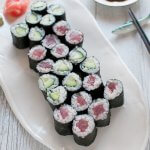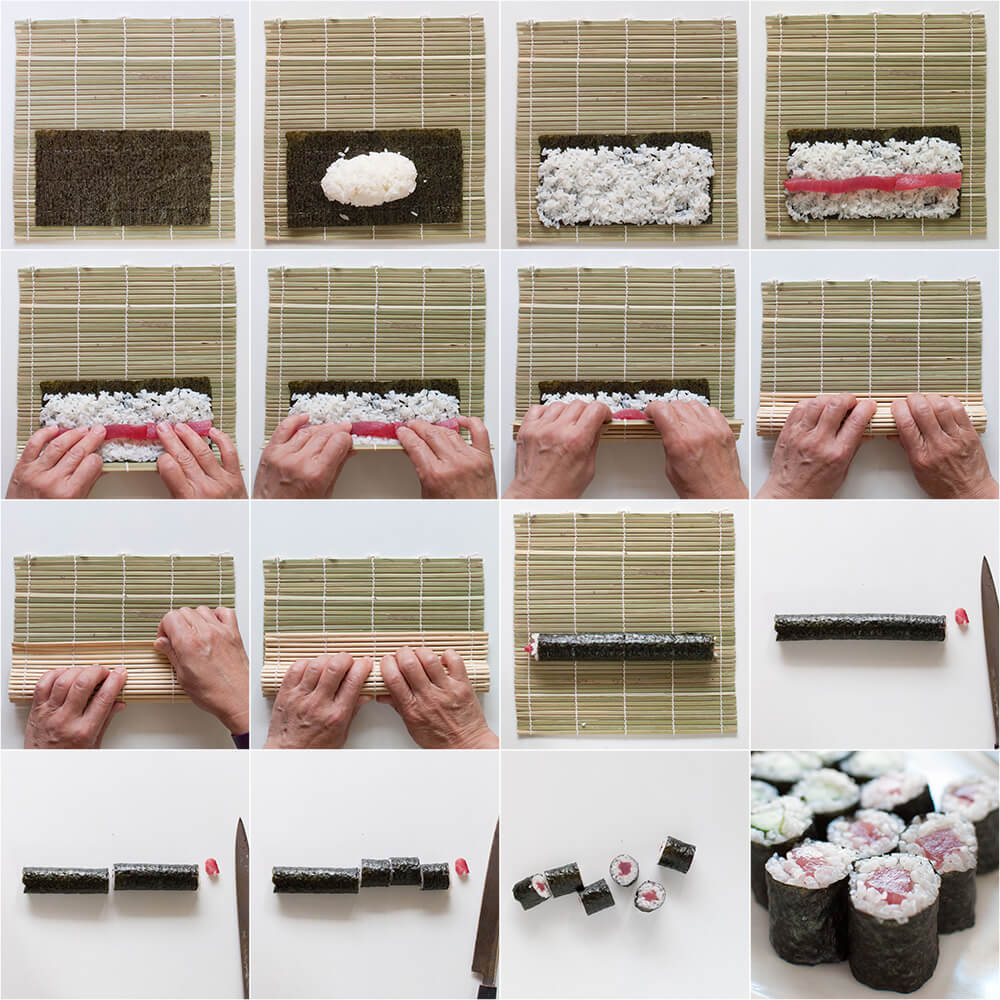
Sushi rolls are becoming a popular healthy take-away food in Australia. Most of them are made as large thick rolls but the sushi rolls made at traditional sushi restaurants are thin, tiny rolls, just perfect as a finger food.
- 50 ml rice wine vinegar (note 1)
- 1 tbsp sugar (note 1)
- ¼ tsp salt (note 1)
- 500 g cooked rice (note 2)
- 3 full size roasted seaweed sheets (yakinori, 焼き海苔)
- ½ cucumber (vertically cut), 20cm long, about 60g (note 3)
- 120 g sashimi (narrow and long shape if possible)
- Bamboo rolling mat / bamboo sushi mat (note 4)
- A small bowl of water mixed with several drops of vinegar
- Soy sauce
- Wasabi (Japanese horse radish, note 5)
- Sweet pickled ginger (note 6)
-
Mix rice wine vinegar, sugar and salt well until sugar is dissolved.
-
When rice is cooked and while it is still very hot, transfer it to a large bowl (wooden if possible), then add half of the vinegar mixture to the rice, spreading evenly.
-
Using a spatula, mix the rice well to evenly mix the vinegar. Use cutting motion to mix the rice with the spatula and do not break or squash the rice grain.
-
Add the remaining vinegar mixture and mix well. Use a handheld fan or thick paper to fan the rice to let the moisture evaporate faster (optional).
-
The roasted seaweed sheet is rectangular. Cut in the centre parallel to the shorter side and make 6 sheets.
-
Cut the cucumber vertically into 3 equal thin strips (long wedges). Thickness of the cucumber strips should be about 1cm. If the centre of the cucumber with seeds is very soft and wet, trim it.
-
Cut the tuna into 1cm wide matchstick strips. Each roll requires a 19cm long strip. You can connect short strips to make 19cm long but you will need 3 lots of them.
-
Place a bamboo mat on the work bench with greenish flat side up (if using traditional mat). The bamboo sticks should be horizontal and the end of the cotton strings should be away from you.
-
Place a sheet of roasted seaweed horizontally on your end of the mat, shiny side facing down. Leave the edge of the seaweed sheet 1-2cm away from the end of the bamboo mat.
-
Wet your fingers with water with vinegar in the bowl (to prevent the rice grains from sticking to your hands), take 1/6 of the sushi rice and make an oval ball. Place it in the middle of the seaweed sheet.
-
Spread the rice over the seaweed sheet to cover the seaweed completely except 1cm of the end of the seaweed sheet away from you (this will overlap with the other end when rolled). If required wet your hands. Ensure that the thickness of the rice is even and press the rice gently when spreading.
-
Place a strip of cucumber or tuna in the centre of the rice. If your cucumber/tuna strips are not as long as the width of the seaweed sheet, connect the short strips so that cucumber/tuna reaches to the both ends.
-
Using the thumb and index finger of both hands, hold the end of the mat and lift it up. Then place your middle fingers and ring fingers on the cucumber/tuna firmly. While placing these fingers on the cucumber/tuna, roll the bamboo mat away from you.
-
When the edge of the seaweed is at the top, let go of your middle and ring fingers and keep rolling slowly until the edge of the seaweed sheet reaches to the other end of the rice.
-
By now, the bamboo mat should be completely covering the sushi roll (don't roll the end of the bamboo mat into the rice!). Press the bamboo mat around the sushi roll gently but firmly.
-
Place your left hand (for right hander) over the bamboo above the sushi roll. Using the other hand, pull the end of the bamboo mat a few centimetres away from you so that the sushi inside the mat rolls further 90 degrees or so, overlapping with the end of the seaweed sheet that does not have rice on it.
-
Using both hands gently but firmly press the bamboo mat over the sushi roll, then remove the mat. Place the sushi roll on the plate/cutting board with the overlapping seaweed line down.
-
Place a sushi roll horizontally on a cutting board. Wipe a knife with a wet cloth.
-
If cucumber/tuna is sticking out at the end of the roll, trim it off. Cut the roll in half, then cut each half of the roll into 3 equal lengths, making 6 small pieces (note 7). Wipe the knife with the wet cloth regularly to remove the rice from the knife.
-
Place the sushi rolls cut side up on a serving plate. Serve with pickled ginger, wasabi paste and soy sauce for dipping.
1. You can buy sushi vinegar from the supermarket or Asian grocery store instead of making it from scratch. For the required quantity of store-bought sushi vinegar, refer to the instructions on the bottle.
2. You need to use sushi rice, short grain rice or medium grain rice (order of preference). Please refer to How to Cook Rice the Japanese Way but add 1 sheet of 10cm x 5cm konbu (kelp) when cooking the rice if you can. This will add umami to the rice.
One cup (250ml) of rice will make just over 500g of cooked rice.
3. My cucumber was called Lebanese cucumber which was 20cm long, 3cm thick and was just right for this. If your cucumber is short, make more strips and connect them when assembling the sushi roll.
4. You can buy a bamboo rolling mat/bamboo sushi mat at the super markets as well as at Japanese/Asian grocery stores. There are two types of mats (please refer to the photos in the post). You can use either type.
5. Some people may not like wasabi which has a kick of strong spiciness. So, I roll the sushi without wasabi inside. But, the traditional sushi roll has wasabi inside when the ingredients have no flavours added. Spread a small amount of wasabi along the cucumber/tuna before rolling if you would like wasabi inside the roll.
6. There are two types of pickled ginger - pickled in sweet vinegar (colour of ginger or slightly pinkish) and pickled in salt and vinegar (bright red). The sweet vinegar ginger is the one to use for sushi. You can find more details about pickled ginger, with photos, in my post Beef Bowl (Gyudon).
7. You can cut a roll into 4 pieces instead of 6 if you are eating the sushi rolls as part of your meal. If serving as a finger food, I think that 6 pieces per roll is better.
